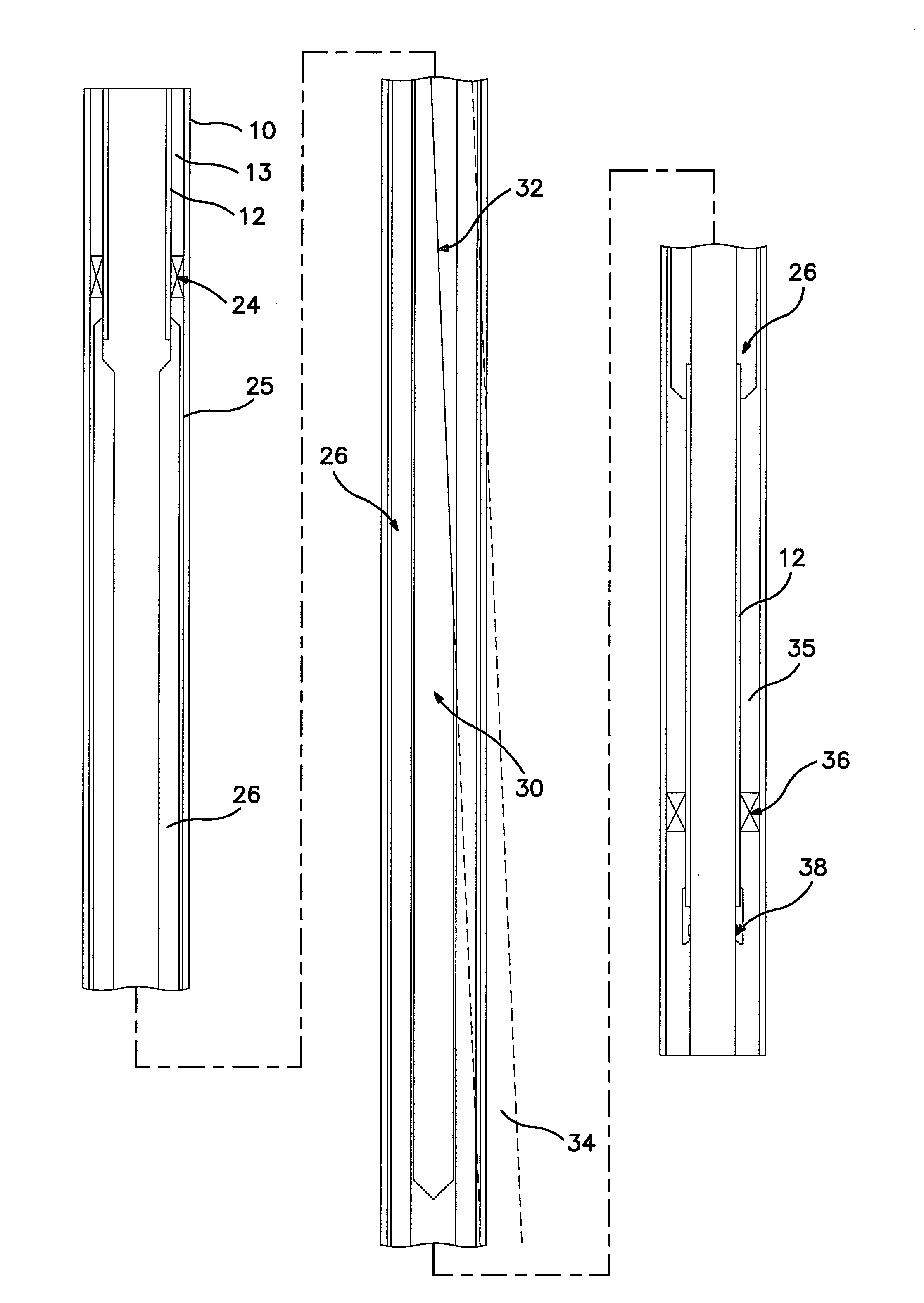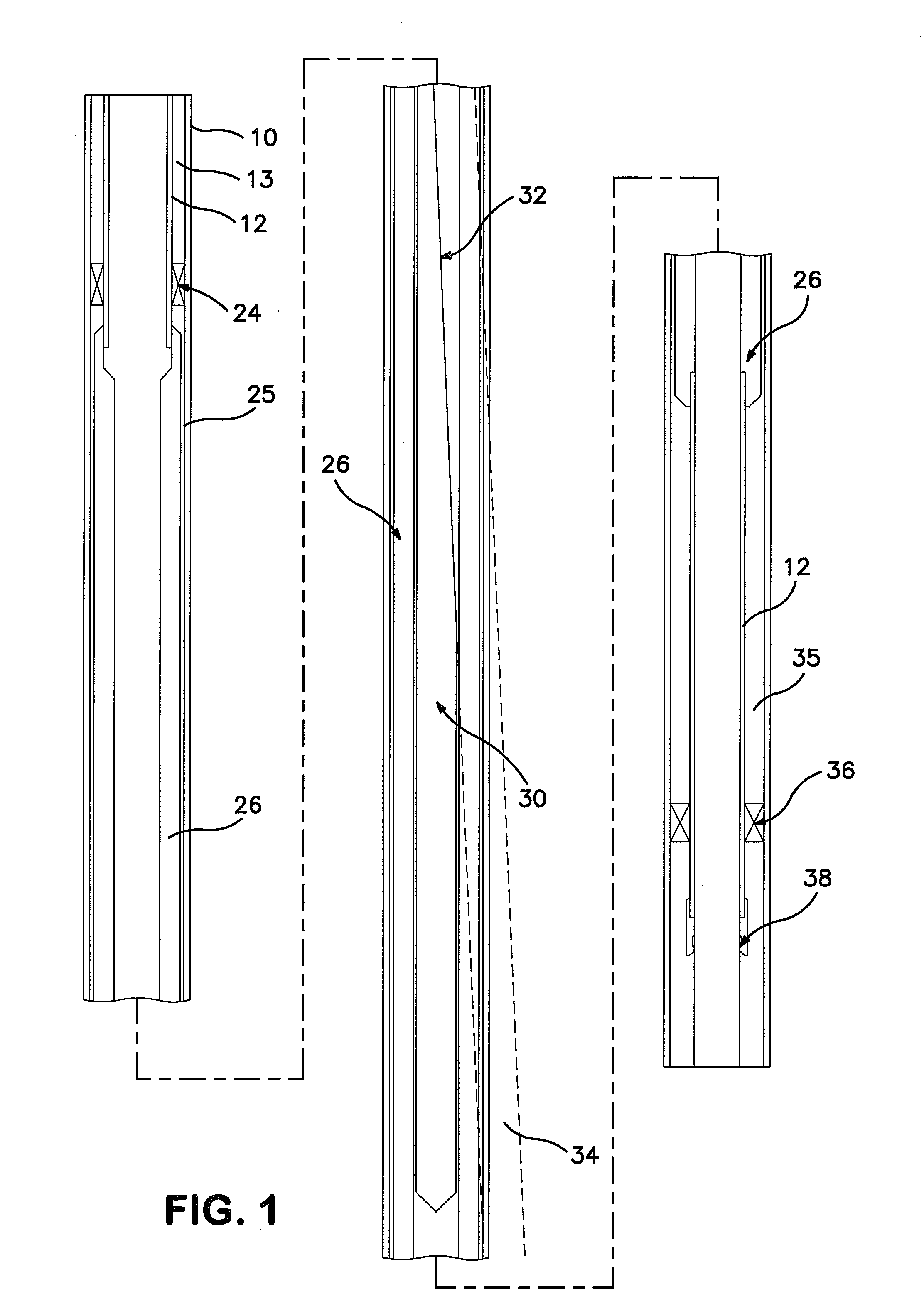[0010]In an embodiment of the present invention, a process for drilling a sidetrack wellbore into a desired formation, wherein the process includes: (a) installing a liner within the formation, wherein the liner includes an outer diameter and an inner diameter; (b) installing a tubing string within the formation, wherein the tubing string includes an inner diameter and an outer diameter; (c) installing a tailpipe releasably attached to the tubing string, wherein the tailpipe includes an inner diameter and an outer diameter, wherein the tailpipe is positioned within the liner with the use of millable stabilizing bands, wherein the millable stabilizing bands are connected to the outer diameter of the tailpipe, wherein the outer diameter of the tailpipe is increased until the clearance between the tailpipe and the liner can be safely run into the formation, wherein a diametrical clearance between the tailpipe and the liner is between about ⅛ inch to about ¼ inch, wherein the inner diameter of the tailpipe is larger than the inner diameter of the liner, wherein the tailpipe is fabricated from a durable material capable of being milled; (d) installing a packer assembly, wherein the packer assembly is located along the tubing string and above the tailpipe; (e) installing a whipstock assembly, wherein the whipstock assembly includes an inclined guide surface, wherein the whipstock assembly includes a heel, wherein the tailpipe positions the whipstock assembly near a centerline within the liner, wherein the difference between the inner diameter of the liner and the maximum deviation of the whipstock from the centerline in the formation is minimized to about ½ the value of the diametrical clearance, thereby reducing the distance between the heel of the whipstock to the inner wall of the liner, wherein the whipstock assembly is guided into the formation to a desired location within the tailpipe, wherein the whipstock assembly is then set in place at the desired location within the tailpipe; (f) guiding a milling assembly into the formation through the tailpipe and onto the inclined guide surface of the whipstock assembly, wherein the milling assembly is a straight motor mill; and (g) milling through the tailpipe and the liner in a single milling operation.
[0011]In a further embodiment of the present invention, a process for drilling a sidetrack wellbore into a desired formation, wherein the process includes: (a) installing a liner within the formation, wherein the liner includes an outer diameter and an inner diameter; (b) installing a tubing string within the formation, wherein the tubing string includes an inner diameter and an outer diameter; (c) installing a tailpipe releasably attached to the tubing string, wherein the tailpipe includes an inner diameter and an outer diameter, wherein the outer diameter of the tailpipe is increased until the clearance between the tailpipe and the liner can be safely run into the formation; (d) installing a whipstock assembly, wherein the whipstock assembly includes an inclined guide surface, wherein the whipstock assembly includes a heel, wherein the tailpipe positions the whipstock assembly near a centerline within the liner, wherein the difference between the inner diameter of the liner and the maximum deviation of the whipstock from the centerline in the formation is minimized to less than the value of the diametrical clearance, thereby reducing the distance between the heel of the whipstock to the inner wall of the liner, wherein the whipstock assembly is guided into the formation to a desired location within the tailpipe, wherein the whipstock assembly is then set in place at the desired location within the tailpipe; (e) guiding a milling assembly into the formation through the tailpipe and onto the inclined guide surface of the whipstock assembly; and (f) milling through the tailpipe and the liner.
[0012]In another embodiment of the present invention, a system for drilling a sidetrack wellbore into a desired formation, wherein the system includes: (a) a liner within the formation, wherein the liner includes an outer diameter and an inner diameter; (b) a tubing string within the formation, wherein the tubing string includes an inner diameter and an outer diameter; (c) a tailpipe releasably attached to the tubing string, wherein the tailpipe includes an inner diameter and an outer diameter, wherein the outer diameter of the tailpipe is increased until the clearance between the tailpipe and the liner can be safely run into the formation; (d) a whipstock assembly, wherein the whipstock assembly includes an inclined guide surface, wherein the whipstock assembly includes a heel, wherein the tailpipe positions the whipstock assembly near a centerline within the liner, wherein the difference between the inner diameter of the liner and the maximum deviation of the whipstock from the centerline is minimized to about ½ the value of the diametrical clearance, thereby reducing the distance between the heel of the whipstock to the inner wall of the liner; and (e) a milling assembly into the formation through the tailpipe and onto the inclined guide surface of the whipstock assembly, wherein the milling assembly mills through the tailpipe and the liner.
 Login to View More
Login to View More  Login to View More
Login to View More 

